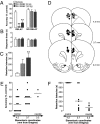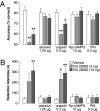Glucocorticoids in the prefrontal cortex enhance memory consolidation and impair working memory by a common neural mechanism
- PMID: 20810923
- PMCID: PMC2944727
- DOI: 10.1073/pnas.1011975107
Glucocorticoids in the prefrontal cortex enhance memory consolidation and impair working memory by a common neural mechanism
Abstract
It is well established that acute administration of adrenocortical hormones enhances the consolidation of memories of emotional experiences and, concurrently, impairs working memory. These different glucocorticoid effects on these two memory functions have generally been considered to be independently regulated processes. Here we report that a glucocorticoid receptor agonist administered into the medial prefrontal cortex (mPFC) of male Sprague-Dawley rats both enhances memory consolidation and impairs working memory. Both memory effects are mediated by activation of a membrane-bound steroid receptor and depend on noradrenergic activity within the mPFC to increase levels of cAMP-dependent protein kinase. These findings provide direct evidence that glucocorticoid effects on both memory consolidation and working memory share a common neural influence within the mPFC.
Conflict of interest statement
The authors declare no conflict of interest.
Figures






References
-
- Lupien SJ, Gillin CJ, Hauger RL. Working memory is more sensitive than declarative memory to the acute effects of corticosteroids: A dose-response study in humans. Behav Neurosci. 1999;113:420–430. - PubMed
-
- Buchanan TW, Lovallo WR. Enhanced memory for emotional material following stress-level cortisol treatment in humans. Psychoneuroendocrinology. 2001;26:307–317. - PubMed
-
- Roozendaal B, Barsegyan A, Lee S. Adrenal stress hormones, amygdala activation, and memory for emotionally arousing experiences. Prog Brain Res. 2008;167:79–97. - PubMed
-
- McGaugh JL. Memory consolidation and the amygdala: A systems perspective. Trends Neurosci. 2002;25:456–461. - PubMed
Publication types
MeSH terms
Substances
Grants and funding
LinkOut - more resources
Full Text Sources
Medical

